
Posts Tagged: Berries
Banana Industry Under Pressure, Implies a Huge Plus for Berry Growers
Just doing the usual weekend reading and came across this gem in The Economist:
Seems banana producers down south are facing serious challenges from two pathogenic fungi. One pathogen has become resistant to the fungicide complex used to control it and a strain of the other pathogen has overcome the resistance to it by the most widely planted banana variety.
Not that I would ever be happy about the travails of fellow agriculturists, but knowing that bananas are far and beyond the most consumed fruit by Americans (33 lbs/year well beyond the second place apples at 16 lbs/year), the big rise in price of bananas that this impending disease induced reduction in supply implies means an improved market for berries - which are pretty widely consumed in the USA already.
Interesting stuff.

Will the issue of two resistant fungal pathogens in banana production regions of the world mean an improved market for berry growers?
U-pick organic strawberry season opens on coast
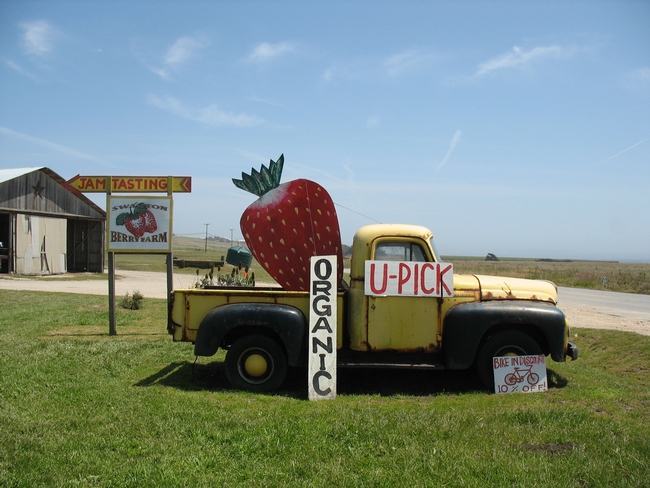
The U-pick strawberry fields at Swanton Berry Farm near Davenport on the coast are formally opening on May 28, but if you drive out there now, you’ll get a chance to pick without a crowd. Talking to Barrett Boaen, the U-pick manager, I got to the bottom of just why their berries, also sold at local Whole Foods stores, look and taste so good.
Partly it’s the ‘Chandler’ variety, chosen for its old-fashioned sweetness and flavor although it yields only about two-thirds as well as some varieties. It’s also about not pumping up production with too much nitrogen or irrigation (more details here). Mostly, though, it’s about the picking process. A strawberry grower visiting from the East Coast recently bought two flats from the farmstand, saying he couldn’t help himself, he had never laid eyes on such beautiful organic berries, and he knew who to congratulate—the pickers.
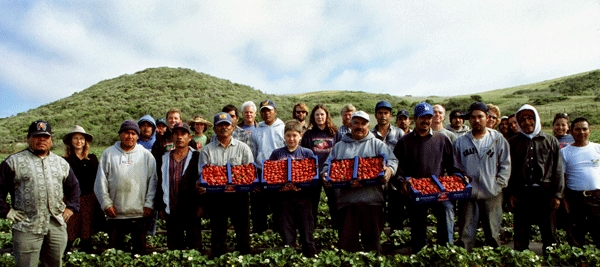
You and I are unlikely to come close to picking as well as Swanton’s unionized employees, some of whom have more than 20 years of experience at the farm. They recognize when a strawberry is as ripe as it can be, when it’s red and sweet all the way through (strawberries don’t continue ripening once they are picked). Although a less ripe berry is firmer, with a longer shelf-life and easier to transport, it has less flavor, so the pickers wait a day or two for any berry with a green tip or white shoulders to ripen perfectly. They discard berries that are soft on one side (from raindrops settling on the fruit) or have a cat-face look, which is lygus bug damage.
Moving along the rows, which are banked up to 18 inches high to reduce back strain, they harvest each perfectly ripe berry, with its green calyx attached, in a “twist and flick” motion: “you put tension on the stem above the calyx, and rotate it, so you can see 360 degrees and whether there’s any damage to the berry; then with just the right tension, the berry will pop off naturally,” explains Boaen.
In the U-pick fields, which have ocean views, visitors pick for pleasure, hopping from row to row, enjoying the fresh air, and the fragrance of the berries and the earth. Compared to the serious work in the other 20 acres of strawberries, “the 3 acres of U-pick are a playground,” says Boaen, “We provide people everything they need to be happy.”
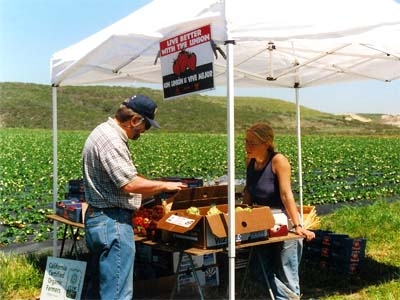
“It can be demoralizing,” Boaen admits. “All that energy put into the fruit after the excellent warm January was wrecked.”
Fortunately, the farm has several other crops, and the strawberry fields are filling with new berries. You can pick them this summer for $2.50 per pound (10 percent discount for bicyclists). Bring your own containers if you remember, a windproof jacket and boots in case of fog or mud, and most of all, Boaen recommends allowing plenty of time to enjoy yourself.
By mid-June, Swanton ollalieberries will be ripe, and by mid- or late July, the blackberries will be ready. Farm tours are available by reservation. Organic strawberry and ollalieberry jams, and five other kinds, are available at the farmstand or online.
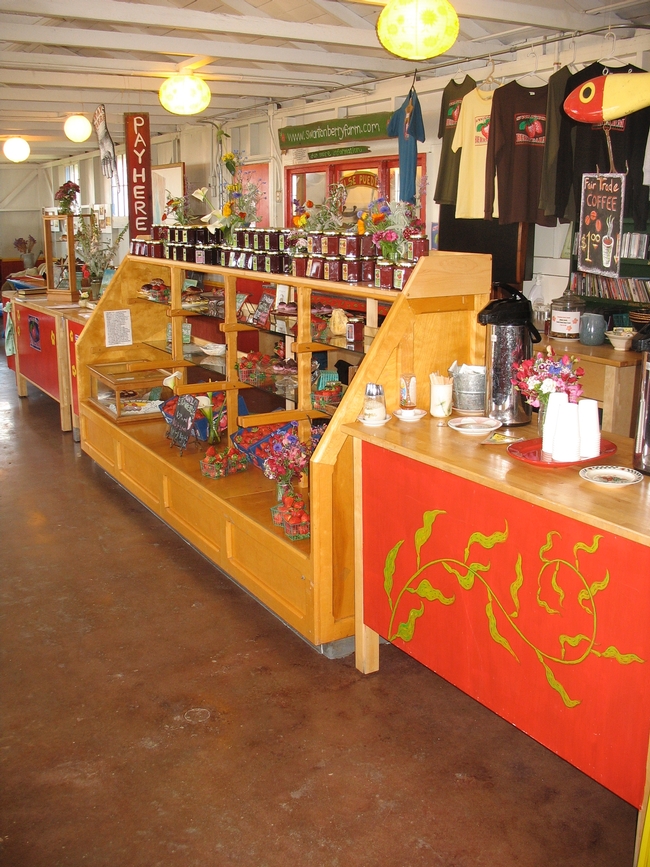
Swanton's farmstand
It looks great, but does it taste great?
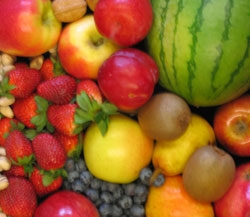
Americans, after years of hearing that fresh produce is valuable for numerous health benefits, have still not significantly increased their consumption. So, why don’t we eat more fruits and vegetables? Researchers believe that the key reason is that the quality of produce is inconsistent – often with poor texture, flavor or aroma. It might look beautiful on the outside, but when you take a bite – Ugh! It just doesn’t match up to its attractive exterior.
Most produce found at the local market is harvested from the field or orchard before it is fully ripe, shipped a long distance, and then the ripening is completed at a regional produce distribution center or at the local market.
“Harvesting produce early reduces losses due to bruises, decay and other defects,” explained Beth Mitcham, SCRI Grant UCD project leader, “but oftentimes the product never reaches its potential, a full ripe flavor or aroma. Fresh produce, especially when harvested near full ripe stage, can be challenging to handle properly.”
The SCRI grant is an ambitious effort to understand what characteristics are critical for consumers to enjoy produce and develop better methods to measure flavor quality, then work with better tasting varietals and improved shipping and handling practices to allow economically viable delivery of truly delicious fruits and vegetables.
Consumer focus groups are being interviewed for their input, trained taste panels are enjoying a variety fresh produce, and experiments with pallet shrouds and other modified atmosphere transportation experiments are underway. Significant information has already been elicited from consumer groups. Through focus groups, the investigators have discovered that aroma and texture are nearly as important as sweetness, and shoppers get really irritated when produce looks good but tastes bad, and this keeps repeat purchases to a minimum.
Produce managers also have a tough time: set up displays of produce, keep it at the right temperature, watch people wandering around squeezing everything to see if their firmness requirements are met, meanwhile damaging the fruit. It’s a tough market for fresh fruit these days, with fewer consumers’ dollars allocated for produce purchases, but with the advances researchers are making through the SCRI project and others, sweet success is on the way.
Note: This topic was featured on a CBS13 (KOVR) News clip dated 7/17/10, see: http://www.cbs13.com/video/?id=76639@kovr.dayport.com

Winegrapes ripen, unless berry shrivel strikes
August visitors to California wine country can see winegrapes ripening – green changing to gold, red and purple. This is the critical final stage of development, and its success drives one of the state's economic engines, with wine sales generating $18 billion in revenue in 2009. Wine country is also a tourist magnet and a job generator; the industry has a $61.5 billion economic impact statewide each year.
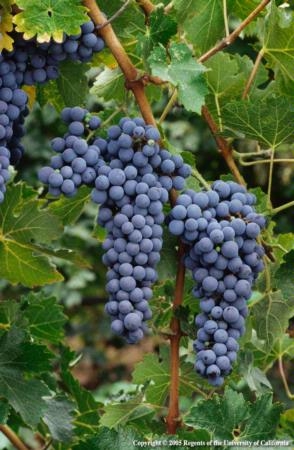
However, in recent years growers have become increasingly concerned about a malady that appears during this phase. Known as “berry shrivel,” this disorder leads to shriveling of berries on a cluster.
There are several kinds of berry shrivel. Of greatest concern to growers and winemakers are sugar accumulation disorder (SAD), in which grapes turn flabby and lack sugar, and bunchstem necrosis, (BSN) in which grapes turn raisin-like on the vine, losing juice and often developing undesirably high sugar content. (See California Agriculture) Either of these disorders makes the fruit less desirable for winemaking, with yield and production losses.

Berry shrivel afflicts both red and white varieties. Cabernet Sauvignon and Merlot are the major red varieties to be affected so far. Among the white varieties, Sauvignon Blanc, Chardonnay, Semillon and Riesling have shown symptoms.
The malady usually becomes apparent when winemakers or sugar samplers are in the vineyard tasting fruit. Once detected, vintners will often make a pass through the vineyard just ahead of the harvest crew to drop this fruit due to its low sugar content and off-flavored juice.
"Berry shrivel usually affects a small proportion of a vineyard's fruit – perhaps 5 percent -- but in particular vineyards and years, shriveling can affect more than half of the crop," says Mark Krasnow, who was a postdoctoral student at UC Davis and is now at the Eastern Institute of Technology in Hawke’s Bay, New Zealand. "In some years and some sites, wineries will decide not to harvest a vineyard due to the amount of shrivel. Fortunately this is rare."
The origins of SAD and BSN are a mystery, in spite of research investigations. Krasnow and his colleagues at UC ran a battery of high-tech tests to determine the factors involved, but found little consistency in results and to date, all tests for pathogenic organisms have been negative.
Whether due to SAD or BSN — berry shrivel occurs in vineyards all over the world, managed under different climates, making it a globally significant problem in winemaking.
"The irregularity of when and where (or if) SAD and BSN occur makes them very difficult to study," Krasner notes. Tests conducted by UC Davis Foundation Plant Services were negative for phytoplasmas, closteroviruses (leafroll), fanleaf viruses, nepoviruses and fleck complex viruses.
“It is possible that SAD has multiple causes, and that one of those causes might be a pathogen,” Krasnow says. “In some cases, all the fruit on a vine is affected, even clusters that appear outwardly normal. In other cases, it is only the symptomatic fruit that develops abnormally.”
Preliminary studies suggest that SAD can be propagated by chip budding, but vine-to-vine spread has not been seen, according to Krasnow. Future studies will focus on tests for a causal organism and a more careful examination of the metabolism of fruit affected by this disorder.
Bunchstem necrosis also varies in symptoms and whether effects occur on clusters or whole vines, and can occur at bloom or at ripening (veraison). Future studies will examine varietal differences in susceptibility having to do with xylem structure, the importance of concentrations of mineral nutrients, and other cultural factors.
